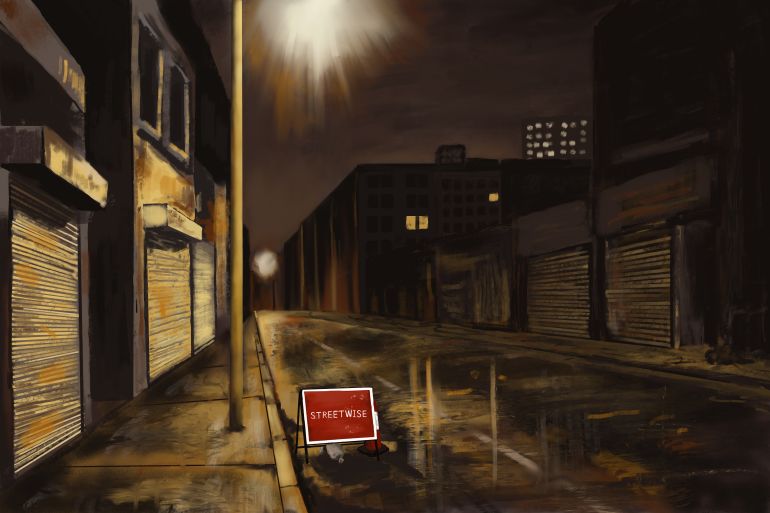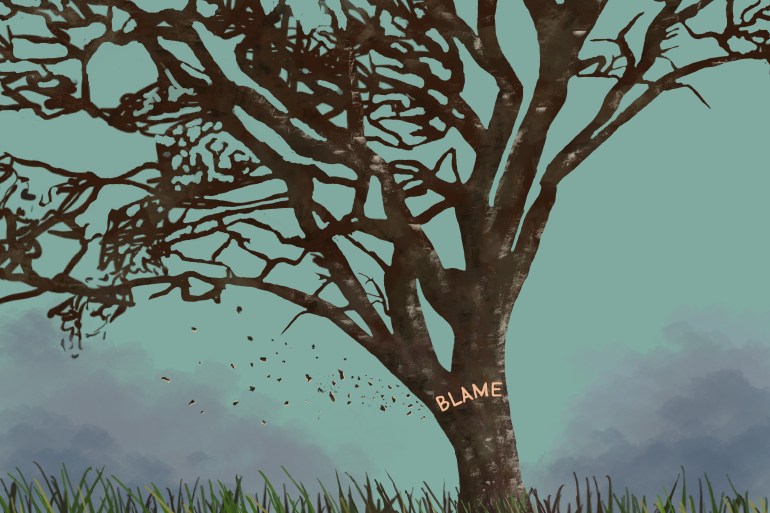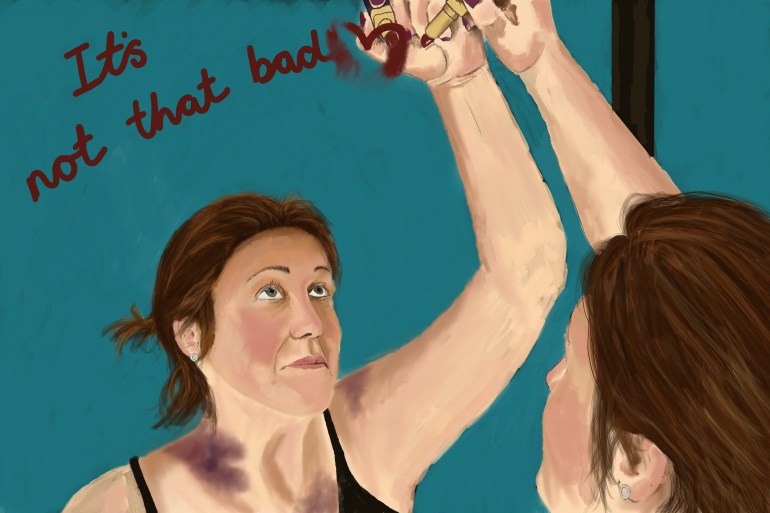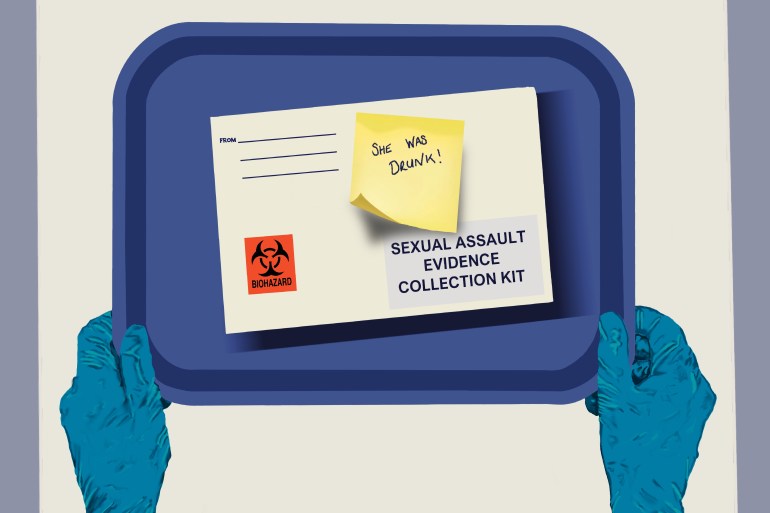How not to blame a woman for being murdered
A guide to not being a victim-blamer.

In March, a police officer kidnapped a 33-year-old woman as she walked home from a friend’s house in south London. Wayne Couzens lured Sarah Everard into his car by using his warrant card to falsely arrest her. He then raped and murdered her.
A few months later, following Couzens’s sentencing, Philip Allot, North Yorkshire’s police, fire and crime commissioner, participated in a radio discussion about the case. “So women, first of all, need to be streetwise about when they can be arrested and when they can’t be arrested. She should never have been arrested and submitted to that,” he said.
Keep reading
list of 4 itemsFive ways to move on from an abusive relationship
The price of the false or non-apology
‘His steel toed boot plunged into my ribs’
“Perhaps women need to consider in terms of the legal process, to just learn a bit about that process,” he said.
Allot resigned after listeners, social media users, some politicians and others pointed out that the blame for the murder lays solely with the man who had committed it; rather than the woman who had been a victim of it. But his manner of thinking is far from uncommon. And when public officials make statements like these, they seep into every part of society – influencing how people view victims of violence and even how victims view themselves. These behaviours become so embedded in our societies that it is sometimes difficult to see them for what they are: victim-blaming. The impact on how a victim sees herself and her place in the world can be brutal and the resulting shame and paralysis can keep victims silenced and trapped in abusive situations for years.
I know this because I have lived it. I learned to apologise when my abuser abused me, believing it might protect me and appease him (I soon discovered that nothing I said or did would stop him from attacking me – with his words, his controlling behaviour and his fists). I learned to tell friends who had witnessed it that the fault was really mine or that he had a legitimate reason for being so angry at me. I learned to adapt my behaviour; the way I dressed, the words I spoke, the people I interacted with. And I learned never to report it – because the blame would surely be mine.
Decades later, my situation may have changed but victim-blaming is as prevalent as ever and women the world over are still being blamed for their own abuse and even murders. Here are a few ways to spot and then stop victim-blaming.
1. Understand that abusers groom their victims to accept the blame
For eight years, I lived with and loved my abuser. I loved the side of him that was funny and smart, that was often kind and caring. I watched him as he tried to nurture injured birds back to health. I saw him cut large burls off trees and transform those hunks of wood into beautiful, delicate wooden boxes. He made me feel safe where we lived isolated in the woods of New Hampshire, when groups of shotgun-wielding men, angry that we would not let them hunt on our land, would sit drinking in their trucks outside our house all night.
I loved my abuser, Scott*, because he had a grief wound that matched mine: the death of a close family member he had never known. His father had died before he was two; my brother had died the year before I was born. Those losses, ones we rarely spoke of with other people, bonded us.
So, in the early stages of our relationship – when he would blame me for making him angry and irritable – it was easy to accept that his feelings and reactions were my fault, because victim-blaming by abusers often begins slowly and seems harmless.

One of the early triggers for violence in my relationship with Scott was when he thought I was being flirtatious with his friends. That was something I felt I could easily remedy. I toned down my sense of humour; I made sure I wore jeans instead of skirts; I interacted less when other people were around us.
But as the months passed, the blame grew until it did not matter what I did, said or wore. Scott would become angry and hit me for reasons I could not even identify. So I lived in fear all the time, constantly watching over my shoulder for the next verbal tirade or wine bottle hurtling in my direction. It did not take long before I no longer had to wait for Scott to blame me, because I had learned to instantly blame myself.
In a more dramatic case, Katrina Brownlee, a domestic violence survivor who recently retired from a 20-year career with the New York City Police Department, shared her story with The New York Times – including how after her abuser, a prison guard, had shot her 10 times in the abdomen, leaving her paralysed and in a coma and killing her unborn child, she had agreed to say that she shot herself. Homeless and with no support, she feared he would be released from custody and what he would do to her if he was. She had good reason to doubt that those who should have helped her would help her – she had called the police before when her abuser had attacked her, but they had left when they saw his prison guard badge. Still, Brownlee eventually changed her mind and turned up at court. Her abuser pleaded guilty and was sentenced to five to 15 years in prison.
2. ‘If only she had just been more careful’
I never reached out to the police when Scott beat me – smashing me into a concrete floor, kicking me in the ribs with his steel-toed boots or throwing me against walls – because I was certain they would say that if I had just been more careful – with my words or behaviour – that violence would never have happened. I had convinced myself of this too. Had I just been more careful; had I just kept quiet; had I just not walked away from him; had I just not slammed the door.
I had learned that cultural message long before and had it reaffirmed every time I had heard someone make a statement about how they would have acted differently to a victim of violence or how the victim could have prevented her own abuse if only she had just … But this, too, is a form of victim-blaming.
So, whenever I sensed the beginnings of trouble, I tried to make myself small. I willed myself to become invisible. I stayed out of Scott’s way. I watched my words and actions closely so that I would not be guilty of “causing” a violent incident. But this extra care never stopped Scott from hurting me. I now know that this is because violent behaviour is a choice. And it was his choice, not mine.
3. When the authorities decide an abuser and their victim are both to blame
In mid-August, 22-year-old Gabby Petito and her 23-year-old fiance Brian Laundrie were stopped by police in Moab, Arizona, after a bystander called 911 to say he had seen a “gentleman” hitting a “girl”. After speaking to Petito and Laundrie, the police determined that Petito was the aggressor. Petito had told them that Laundrie had grabbed her face, leaving a cut on her cheek, but immediately explained that she had hit him first.
Abused women will often take the blame for a violent incident, particularly when authority figures or others from outside of the relationship are present. And why wouldn’t they when they know those people will soon be gone and they will be left alone with their abuser? They will explain the ways in which they provoked their abuser. And in many cases, police offers – whose approach is often to try to resolve the matter as quickly as possible – simply are not trained to recognise the contradictions in their behaviour. This can lead to blame being attributed to the victim, either in part or whole. In this way, responsibility is removed from the abuser and the isolation of the victim is reinforced. It reminds her that seeking help may result in anything but help.
Petito and Laundrie had been on a cross-country trip together. In early September, Laundrie returned to the home they shared without her. A couple of weeks later, Laundrie went missing and a few days after that, Petito’s body was found. A coroner ruled that she had died by homicide. After a more than month-long manhunt by police who listed Laundrie as a “person of interest”, his remains were found on October 20.
4. Both victim and abuser will minimise the situation
When Petito and Laundrie were pulled over by police, she was described as crying uncontrollably and being in a “confused and emotional” state. He, by contrast, was calm and joking with the police. They both tried to downplay and minimise the situation – allowing the police to do the same. But when the police make a judgement based only on what is presented to them, it can lead to an inaccurate assessment of the situation – with sometimes fatal consequences.
Discussing the bodycam footage of Utah police talking to Petito and Laundrie, Ruth Glenn, the president of the National Coalition Against Domestic Violence, said: “Their response is typical. She is very upset and blaming herself while he is calm and also blaming her.”

In my relationship with Scott, I minimised the seriousness of his abusive behaviour. If he threw a wine bottle but missed my head, I thought, “Well, at least it didn’t hit me.” If I woke with bruises on my chest, I thought, “It’s not so bad. No one can see these. I can still go to work.” When I took a couple of days off work because a friend and her family were visiting, and Scott insisted I pick up a waitressing shift instead – physically backing me into a corner, shouting and grabbing my biceps – I justified his behaviour to my friend. It was no big deal, I told her, and we did need the money.
5. When the victim was ‘hanging around with the wrong people’
After 26-year-old Breonna Taylor was killed by police at her home in March 2020, a video emerged of a high school teacher in Atlanta, Georgia, explaining to her class why it had been her fault. “It’s sad that she put herself in that position but she put herself in that position by hanging out with somebody she shouldn’t have been with,” Susan McCoy could be heard telling her class, having included some misinformation about the circumstances of Taylor’s death in her victim-blaming account of it.
It is a familiar argument to the family of Ashley Heavy Runner Loring, a 20-year-old who went missing from the Blackfeet Indian Reservation in northern Montana in 2017. When her grandmother reported her missing, the police told her they had heard Ashley was hanging out with a “raucous crowd, probably off partying somewhere”. By the time they did begin a search for her, too much critical time had passed to uncover important clues. Two years later, she still has not been found.
6. When the victim ‘has been drinking’
In the late 1990s, when I worked at a shelter for victims of domestic violence in Massachusetts, I was called to the local hospital late one night to assist a rape victim during her rape kit process. No sooner had I walked through the hospital doors than the nurses and police present informed me, “It wasn’t a rape. She was drunk.”
It was my first experience of advocating for a rape victim and I was afraid that my own past experience of being raped would render me ineffective. I was doing all I could to stay in my body and not dissociate as I asked them to take me to the woman’s room.
A nurse and a police officer were present as the woman lay on a hospital gurney, having her vagina probed and scraped for semen samples. Whenever I asked her if she was OK or needed a break, the police officer and nurse would roll their eyes. “She’s drunk,” the nurse kept silently mouthing to me.

I, too, had been drunk when a stranger raped me at a party in Los Angeles. Before it happened, I had been bouncing off the walls, laughing and dancing. When I woke the following morning with the realisation of what had happened, I felt full of shame. I blamed myself because I had been drinking. It was only years later as I underwent training at the domestic violence shelter that I realised it was not my drinking that had made me a victim of rape; it was a rapist.
7. When others see the abuse but stay silent
The first time Scott hit me, a friend of his was present. He said nothing. I internalised that to mean that Scott’s behaviour was acceptable; that I deserved it. That evening was the beginning of eight years of abuse, eight years of blaming myself. Because when you witness violence and stay silent, you reinforce the abuser’s actions. When victims see this, they are less likely to stand up for themselves and less likely to accept an offer of assistance when it does come.
In his daughter’s eulogy, Joseph Petito said, “If there is a relationship that you’re in that might not be the best thing for you, leave it now. Take care of yourself first.” These are wise words that may be difficult for a victim to act on. When you have been belittled and diminished, the idea of taking care of yourself first is not a natural one. But such words settle in the body, rising to the surface every now and again, serving as a reminder of what might be possible.
A few months before I left my abuser, my parents came to visit me. Scott was not there when they first arrived. I had no visible bruises, no black eyes, and as far as I knew, I had kept the abuse a secret from my family. Without referencing anything or anyone, my father told me, “We learned in the Marines you have to take care of yourself first. That’s what you need to do now.” We stared at each other and I nodded, for the first time able to receive a message about my own wellbeing. He had understood that something was wrong and had not blamed me for it. He simply recognised it and spoke about it. Two months later, after eight years of abuse, I left my abuser.
Domestic violence researcher Rachel Louise Snyder has said, “Social attitudes don’t change overnight, and the law is even slower to change. The law follows social movements, not the other way around.” I believe the process of changing social attitudes begins on a personal level. It begins with individuals noticing the violence in their own families and communities. It begins with each of us having the courage to speak up when we recognise abusive behaviour and having the inner strength of purpose to intervene. And it begins when we stop blaming the victim.
* Name changed